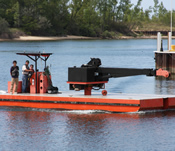Thermoclines
Cary Troy of Purdue University uses the data to understand the lake
Cary Troy relies on the Michigan City buoy to monitor wind speed and direction, surface water temperature, and wave direction to investigate the real-time movement of the thin layer of water below the surface of Lake Michigan known as the thermocline and its impact on the biological productivity of the lake. This layer often blocks colder, nutrient-rich water at the bottom of the lake from mixing with warmer surface water, preventing the circulation of oxygen and nutrients. But in nearshore waters, the thermocline can be disrupted by winds that push warm water below the surface and waves that force colder water to the shore, making it possible for fish and other species to thrive closer to the surface.
Troy proposed the idea of a real-time buoy in the Indiana waters of Lake Michigan because he felt it would transform how he and other researchers study thermoclines and other phenomena in the surrounding area. Information like wind speed and water temperature has in the past been monitored using sensors installed in the spring and removed in the fall, meaning that researchers would only learn about changes in conditions well after they occurred. The buoy moves research into real-time.
“Now, we can watch the data and go out and do some intensive sampling when conditions are what we are looking for,” Troy said.
To learn more about Prof. Troy’s research, visit the homepages of his lab and the Burke Hydraulics and Hydrology Lab at Purdue. For an example of how data like those transmitted via the real-time buoy can be turned into a learning tool, visit here
More Information
- News: Chicago students investigate river water quality
- News: Buoy workshop inspires new STEM activities

Contact
Tomas Hook
Director
765-496-6799
thook@purdue.edu
Carolyn Foley
Research Coordinator
765-494-3601
cfoley@purdue.edu
Angela Archer
Fellowship Program Leader
765-496-3722
amcbride@purdue.edu